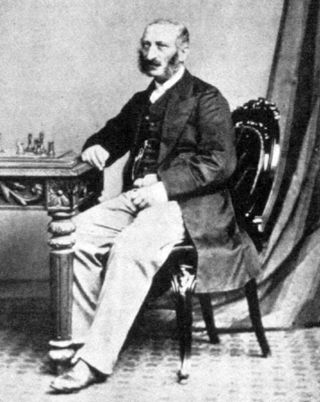
Alexander Aleksandrovich Alekhine was a Russian and French chess player and the fourth World Chess Champion, a title he held for two reigns.

The Great Exhibition of the Works of Industry of All Nations, also known as the Great Exhibition or the Crystal Palace Exhibition, was an international exhibition that took place in Hyde Park, London, from 1 May to 15 October 1851. It was the first in a series of world's fairs, exhibitions of culture and industry that became popular in the 19th century. The event was organised by Henry Cole and Prince Albert, husband of Victoria, Queen of the United Kingdom.

William Steinitz was a Bohemian-Austrian, and later American, chess player. From 1886 to 1894, he was the first World Chess Champion. He was also a highly influential writer and chess theoretician.

Karl Ernst Adolf Anderssen was a German chess master. He won the great international tournaments of 1851 and 1862, but lost matches to Paul Morphy in 1858, and to Wilhelm Steinitz in 1866. Accordingly, he is generally regarded as having been the world's leading chess player from 1851 to 1858, and leading active player from 1862 to 1866, although the title of World Chess Champion did not yet exist.

The International Exhibition of 1862, officially the London International Exhibition of Industry and Art, also known as the Great London Exposition, was a world's fair held from 1 May to 1 November 1862 in South Kensington, London, England. The site now houses museums including the Natural History Museum and the Science Museum.

The British Chess Championships are organised by the English Chess Federation. The main tournament incorporates the British Championship, the English Chess Championships and the British Women's Chess Championship so it is possible, although it has never happened, for one player to win all three titles in the same competition. The English Women's Chess Championship was also incorporated into this event but did not take place in 2015 and was held as a separate competition in 2016. Since 1923 there have been sections for juniors, and since 1982 there has been an over-sixty championship. The championship venue usually changes every year and has been held in different locations in England, Scotland, Wales and once on the Isle of Man.

Johann Jacob Löwenthal was a professional chess master. He was among the top 3 players of the 1850s.

Joseph Henry Blackburne was a British chess player. Nicknamed "The Black Death", he dominated the British scene during the latter part of the 19th century. Blackburne learned the game at the relatively late age of 17 or 18, but he quickly became a strong player and went on to develop a professional chess career that spanned over 50 years. At one point he was one of the world's leading players, with a string of tournament victories behind him, and popularised chess by giving simultaneous and blindfold displays around the country. Blackburne also published a collection of his own games.
In chess, a king walk, also known as a king march, steel king, or wandering king, is a maneuver where the king travels a large distance to a different part of the board in the middlegame or opening. During a king walk, the king may travel along its own side of the board to reach a safer position. Alternatively, it may travel up the board, often involved in a mating attack against the opposing king.

London 1851 was the first international chess tournament. The tournament was conceived and organised by English player Howard Staunton, and marked the first time that the best chess players in Europe would meet in a single event. Adolf Anderssen of Germany won the sixteen-player tournament, earning him the status of the best player in the world.

A chess tournament is a series of chess games played competitively to determine a winning individual or team. Since the first international chess tournament in London, 1851, chess tournaments have become the standard form of chess competition among multiple serious players.
World exhibitions became a new phenomenon in the West in the nineteenth century. Scientific and technical progress were shown. About a dozen World Fairs were organised during the second half of the nineteenth century. Seven times an international invitation chess tournament was part of the event. The third tournament took place in the Grand Cercle, 10 boulevard Montmartre, Paris, from 4 June to 11 July. Thirteen participants played in a double round-robin tournament. Draws counted as zero. The time control was ten moves an hour.
The Paris 1878 chess tournament took place from 17 June to 31 July 1878 during the Paris World Expo. The participation of George Henry Mackenzie and James Mason made it the first intercontinental tournament in Europe. Eleven double rounds were played. Wilhelm Steinitz was present as reporter for The Field.
The Vienna 1873 chess tournament was a side event of the world exhibition of 1873.
The Paris 1900 chess tournament was an event held in conjunction with the Exposition Universelle (1900), one of the world's most notable fairs or exhibitions and designated a "World Exposition" by the Bureau of International Expositions. Major international chess tournaments were also held at six other expositions: London 1851, London 1862, Paris 1867, Vienna 1873, Philadelphia 1876 and Paris 1878. No chess events of significance accompanied, for instance, the Exposition Universelle (1889) in Paris or the World's Columbian Exposition in Chicago in 1893.

The London Chess Classic is a chess festival held at the Olympia Conference Centre, West Kensington, London. The flagship event is a strong invitational tournament between some of the world's top grandmasters. A number of subsidiary events cover a wide range of chess activities, including tournaments suitable for norm and title seekers, junior events, amateur competitions, simultaneous exhibitions, coaching, and lectures.

The World Chess Hall of Fame (WCHOF) is a nonprofit collecting institution in the Central West End neighborhood of St. Louis, Missouri, United States. Founded in 1984, it features chess exhibits, engages in educational outreach, and maintains a list of inductees to the U.S. Chess Hall of Fame and World Chess Hall of Fame.

Lichess is a free and open-source Internet chess server run by a non-profit organization of the same name. Users of the site can play online chess anonymously and optionally register an account to play rated games. Lichess is ad-free and all the features are available for free, as the site is funded by donations from patrons. Features include chess puzzles, computer analysis, tournaments and chess variants.
The Grand Chess Tour (GCT) is a circuit of chess tournaments in which players compete for multiple prize pools. The tournaments, which vary from year to year, have included Norway Chess, the Sinquefield Cup, and the London Chess Classic.
 Adolf Anderssen (Prussia)
Adolf Anderssen (Prussia) Louis Paulsen (German Confederation)
Louis Paulsen (German Confederation) John Owen (United Kingdom)
John Owen (United Kingdom) George Alcock MacDonnell (United Kingdom)
George Alcock MacDonnell (United Kingdom) Serafino Dubois (Kingdom of Italy)
Serafino Dubois (Kingdom of Italy) Wilhelm Steinitz (Austrian Empire)
Wilhelm Steinitz (Austrian Empire) Thomas Wilson Barnes (United Kingdom)
Thomas Wilson Barnes (United Kingdom) James Hannah (United Kingdom)
James Hannah (United Kingdom) Joseph Henry Blackburne (United Kingdom)
Joseph Henry Blackburne (United Kingdom) Johann Jacob Löwenthal (Austrian Empire)
Johann Jacob Löwenthal (Austrian Empire) James Robey (United Kingdom)
James Robey (United Kingdom) Frederick Deacon (Belgium)
Frederick Deacon (Belgium) Augustus Mongredien (United Kingdom)
Augustus Mongredien (United Kingdom) Valentine Green (United Kingdom)
Valentine Green (United Kingdom)










